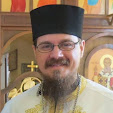Sometimes someone will object that we should not pray for the saints and especially not for the Theotokos. They are already with Christ, after all! We should pray to them, but surely we should not pray for them! They should pray for us!
Well, if we understand what actually occurs in the Liturgy, prayer for (ὑπερ) all the saints and especially for the Theotokos will not scandalize us. The Divine Liturgy, inasmuch as it participates in Christ, is the instrument of all salvation, even and especially that of his mother. Praying for the Theotokos, we still acknowledge that her salvation is already accomplished, but that is just the point – so is ours, in Christ, if we accept it as she has. This liturgical prayer, which the celebrant offers immediately after the epiklesis, is not bound by chronological time (χρόνος).















2 comments:
How long has this tradition been practiced in Eastern Catholic Churches?Admittedly as a Cradle Latin Rite,the concept of praying for saints & the blessed mother are new to my ears.
This prayer is contained in the anaphora of St. John Chrysostom, which dates to about the fifth century. I have not researched its precedents.
The anaphora of St. Basil is a bit older, I believe (c. 4th century). The analogous prayer in that anaphora reads as follows:
"May we obtain mercy and grace together with all the saints who have pleased you since time began: the forefathers, fathers, patriarchs, prophets, apostles, preachers, evangelists, martyrs, confessors, teachers, and with every just spirit brought to perfection in faith, especially with our most holy, most pure, most blessed and glorious Lady, the Theotokos and Ever-Virgin Mary."
Post a Comment